
Magneto-Optical Q-Switched Laser Generates Unpolarized Light
source:Photonics
release:Nick
keywords: Q-Switched Laser Unpolarized Light
Time:2018-02-02
TOYOHASHI, Japan, Feb. 1, 2018 — By using a technique — called q-switching — that utilizes short but high-powered pulse outputs, a laser one-tenth of the size of an American penny produced a beam that is 10 times more powerful than previously reported with larger lasers. The q-switch was performed in a Nd:YAG laser cavity.
A research team from Toyohashi University of Technology fabricated the quasi-continuous-wave (QCW) diode-pumped Nd:YAG laser cavity, which was shortened to 10 mm in length and contained a RIG film and a pair of small coils.
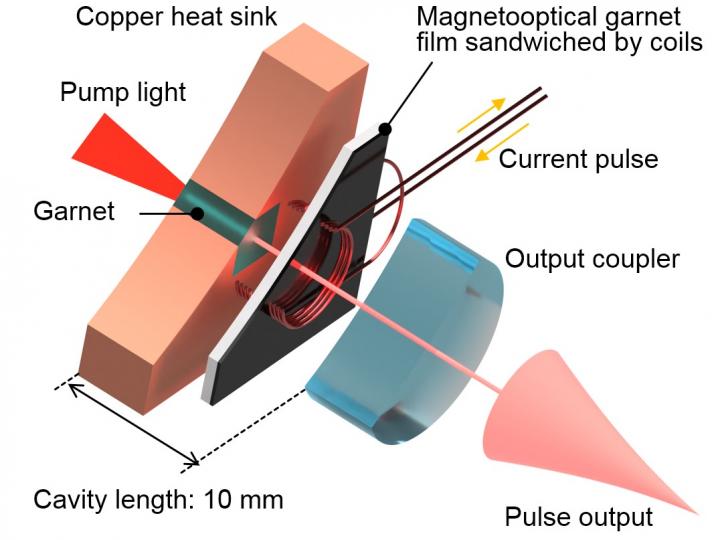
The first high-powered, randomly polarized laser beam with a q-switch laser. Optical pulses were controlled by electrical signals. Courtesy of Toyohashi University of Technology
In experiments, the cavity yielded a 1,064.58-nm wavelength pulse with 25-ns duration and 1.1-kW peak power at a 1-kHz repetition ratio. The polarization state was random because of the isotropic crystal structure of Nd:YAG as well as the fact that the magneto-optical Q-switch incorporating the RIG film did not require the presence of polarizers in the cavity.
“The experimental evidence provided in this study advances this research field toward the realization of actively controllable integrated microlasers,” said professor Taichi Goto.
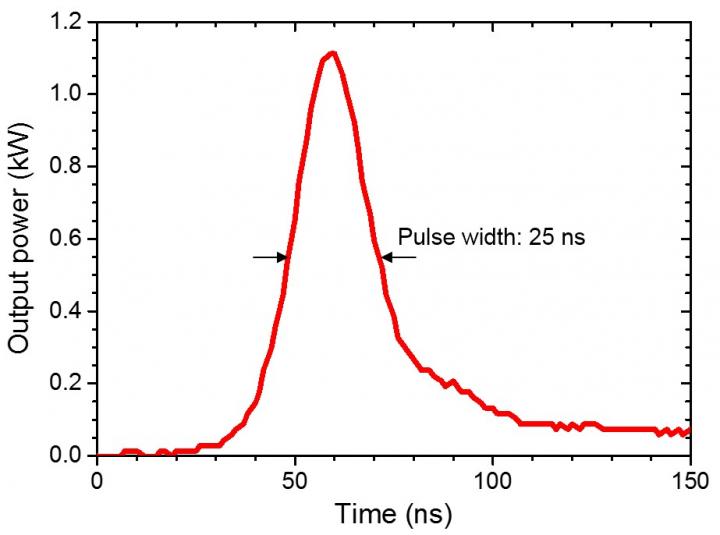
This is an obtained optical pulse. The peak power was about 1 kW. The pulse width was 25 ns. Courtesy of Toyohashi University of Technology.
Along with changing the laser size, the team adjusted the magnetic material through which the light traveled and was amplified. The use of a Nd:YAG laser allowed the team to use magneto-optics to better control how the light moved within the laser cavity.
The introduction of a high-powered, randomly polarized laser beam with a magneto-optical q-switched laser could help broaden the applications for small, powerful lasers. q-switch lasers are used in a variety of applications, including in surgical procedures, and can produce more precise results with less damage than traditional tools. For maximum efficiency, these lasers require active and passive responsibilities.
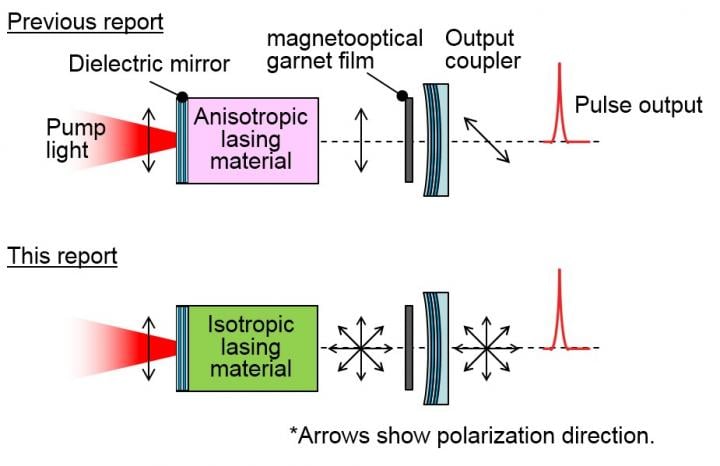
For the first time, randomly polarized (unpolarized) light was generated using a magneto-optical q-switched laser, opening a new field of applications. Courtesy of Toyohashi University of Technology
“There are two advantages to actively controlling integrated microlasers,” said Goto. “The size is small, and mass production techniques can be used. The price of one piece of q-switch laser can be decreased by the integration.”
The researchers plan to increase the peak power of their system, said Goto. They also plan to apply the system as an integrated micro laser for further testing.
A research team from Toyohashi University of Technology fabricated the quasi-continuous-wave (QCW) diode-pumped Nd:YAG laser cavity, which was shortened to 10 mm in length and contained a RIG film and a pair of small coils.

The first high-powered, randomly polarized laser beam with a q-switch laser. Optical pulses were controlled by electrical signals. Courtesy of Toyohashi University of Technology
In experiments, the cavity yielded a 1,064.58-nm wavelength pulse with 25-ns duration and 1.1-kW peak power at a 1-kHz repetition ratio. The polarization state was random because of the isotropic crystal structure of Nd:YAG as well as the fact that the magneto-optical Q-switch incorporating the RIG film did not require the presence of polarizers in the cavity.
“The experimental evidence provided in this study advances this research field toward the realization of actively controllable integrated microlasers,” said professor Taichi Goto.

This is an obtained optical pulse. The peak power was about 1 kW. The pulse width was 25 ns. Courtesy of Toyohashi University of Technology.
Along with changing the laser size, the team adjusted the magnetic material through which the light traveled and was amplified. The use of a Nd:YAG laser allowed the team to use magneto-optics to better control how the light moved within the laser cavity.
The introduction of a high-powered, randomly polarized laser beam with a magneto-optical q-switched laser could help broaden the applications for small, powerful lasers. q-switch lasers are used in a variety of applications, including in surgical procedures, and can produce more precise results with less damage than traditional tools. For maximum efficiency, these lasers require active and passive responsibilities.

For the first time, randomly polarized (unpolarized) light was generated using a magneto-optical q-switched laser, opening a new field of applications. Courtesy of Toyohashi University of Technology
“There are two advantages to actively controlling integrated microlasers,” said Goto. “The size is small, and mass production techniques can be used. The price of one piece of q-switch laser can be decreased by the integration.”
The researchers plan to increase the peak power of their system, said Goto. They also plan to apply the system as an integrated micro laser for further testing.
MOST READ
- RoboSense is to Produce the First Chinese Multi-beam LiDAR
- China is to Accelerate the Development of Laser Hardening Application
- Han’s Laser Buys Canadian Fiber Specialist CorActive
- SPI Lasers continues it expansion in China, appointing a dedicated Sales Director
- Laser Coating Removal Robot for Aircraft
PRODUCTS
 FISBA exhibits Customized Solutions for Minimally Invasive Medical Endoscopic Devices at COMPAMED in
FISBA exhibits Customized Solutions for Minimally Invasive Medical Endoscopic Devices at COMPAMED in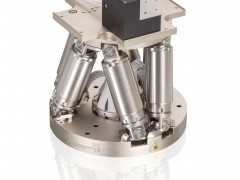 New Active Alignment System for the Coupling of Photonic Structures to Fiber Arrays
New Active Alignment System for the Coupling of Photonic Structures to Fiber Arrays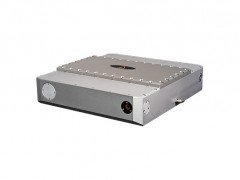 A new industrial compression module by Amplitude
A new industrial compression module by Amplitude Menhir Photonics Introduces the MENHIR-1550 The Industry's First Turnkey Femtosecond Laser of
Menhir Photonics Introduces the MENHIR-1550 The Industry's First Turnkey Femtosecond Laser of Shenzhen DNE Laser introduced new generation D-FAST cutting machine (12000 W)
more>>
Shenzhen DNE Laser introduced new generation D-FAST cutting machine (12000 W)
more>>
